Hi, I'd say Allium neapolitanum, an European species with green anthers.
- Welcome to PBS Forum.
This section allows you to view all posts made by this member. Note that you can only see posts made in areas you currently have access to.
#32
General Discussion / Re: Private exchanges
March 09, 2024, 05:34:43 AM
I can surely get Acis longifolia.
And very likely
Colchicum kesselringii
Fritillaria tubiformis
Iris stenophylla
There is a possibility to have some bulbs brought to the EU in early summer and have other ones carried to the US at the end of it.
Carlos
And very likely
Colchicum kesselringii
Fritillaria tubiformis
Iris stenophylla
There is a possibility to have some bulbs brought to the EU in early summer and have other ones carried to the US at the end of it.
Carlos
#33
General Discussion / Hippeastrum lara-ricoi and pampeanum
March 09, 2024, 12:39:38 AM
Hi, I was looking for the article where H. pampeanum was published and found this in the old mailing list:
Hippeastrum pampeanum, Hippeastrum lara-ricoi - informationLuca Bove (Tue, 18 Feb 2020 12:46:11 PST)
Hi all I would like to ask for more information on 2 species of Hippeastrum:
Hippeastrum lara-ricoi (Moya, Villalba & Zenteno) Hippeastrum pampeanum.
Can anyone share the official description of plants?
Regards
Luca>
<Jane McGary (Tue, 18 Feb 2020 13:28:23 PST)
Although the monograph on Hippeastrum in Bolivia that we hope to publish someday is by Raul Lara Rico, a senior botanist of that country, that species named in his honor apparently doesn't come from Bolivia, and the other Luca mentions is almost certainly from Argentina.
So, sorry, Idon't have this information.Jane McGary>
I happen to be also looking for the paper of H lara-ricoi.
The journal asks for $20 and I was about to pay, even if I hate having to pay for scientific papers as I know that the money does not go to authors, but it's not so expensive after all, but if someone wants to share the amount...
H. lara-ricoi
One page with photos from the paper is shown when you launch the name:
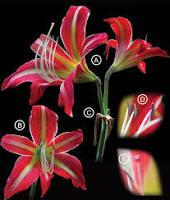
It is indeed a Bolivian plant, apparently very similar, if not the same, as H. yungacense and 'H. escobaruriae'.
I was thinking that it is the plant sold as yungacense by Telos, but it rather seems a hybrid (Kiara?)
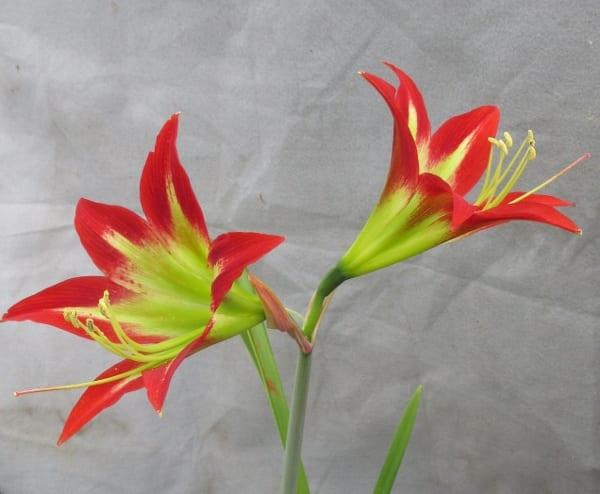
What I consider 'typical' yungacense has flowers of a dull garnet red, even more zygomorphic and reminding of glaucescens that the previous two:
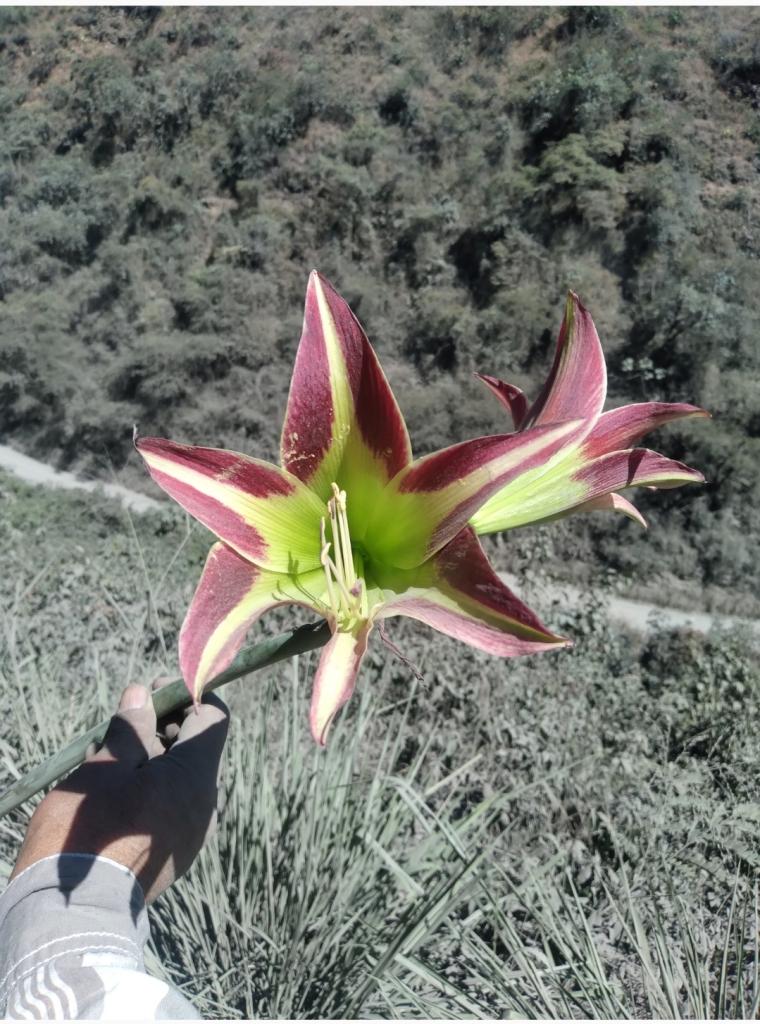
But one could consider that it is intraspecific variation. Both types grow in the same area.
Regarding H pampeanum, the name is misleading as they also call 'pampa' some grassy habitats in Southern Brazil. In addition to this, the name is not in IPNI, so I doubt that it has been published at all.
Telos offers this plant as well, from seed of Regis Bastian surely.
There is something going on with multi-flowered red Hippeastrum in Southern Brazil, as for a long time there was 'only' sanctae-catarinae, but suddenly the splitting fever burst up and now 'there are' laklano, multiflorum, pampeanum, ramboi and one more I forgot, I think.
Even Bastian admits that some are probably the same (I recommend the groups 'Amaryllidaceae: home for all' and 'Planet Botanical Hippeastrum' on Facebook. Even Lara Rico's posts are seen there).
A Russian living in Italy is selling all of them, grown from seed bought from Mauro Peixoto (laklano) and Bastian (the rest). I will buy one of each for my project.
Carlos
Hippeastrum pampeanum, Hippeastrum lara-ricoi - informationLuca Bove (Tue, 18 Feb 2020 12:46:11 PST)
Hi all I would like to ask for more information on 2 species of Hippeastrum:
Hippeastrum lara-ricoi (Moya, Villalba & Zenteno) Hippeastrum pampeanum.
Can anyone share the official description of plants?
Regards
Luca>
<Jane McGary (Tue, 18 Feb 2020 13:28:23 PST)
Although the monograph on Hippeastrum in Bolivia that we hope to publish someday is by Raul Lara Rico, a senior botanist of that country, that species named in his honor apparently doesn't come from Bolivia, and the other Luca mentions is almost certainly from Argentina.
So, sorry, Idon't have this information.Jane McGary>
I happen to be also looking for the paper of H lara-ricoi.
The journal asks for $20 and I was about to pay, even if I hate having to pay for scientific papers as I know that the money does not go to authors, but it's not so expensive after all, but if someone wants to share the amount...
H. lara-ricoi
One page with photos from the paper is shown when you launch the name:
It is indeed a Bolivian plant, apparently very similar, if not the same, as H. yungacense and 'H. escobaruriae'.
I was thinking that it is the plant sold as yungacense by Telos, but it rather seems a hybrid (Kiara?)
What I consider 'typical' yungacense has flowers of a dull garnet red, even more zygomorphic and reminding of glaucescens that the previous two:
But one could consider that it is intraspecific variation. Both types grow in the same area.
Regarding H pampeanum, the name is misleading as they also call 'pampa' some grassy habitats in Southern Brazil. In addition to this, the name is not in IPNI, so I doubt that it has been published at all.
Telos offers this plant as well, from seed of Regis Bastian surely.
There is something going on with multi-flowered red Hippeastrum in Southern Brazil, as for a long time there was 'only' sanctae-catarinae, but suddenly the splitting fever burst up and now 'there are' laklano, multiflorum, pampeanum, ramboi and one more I forgot, I think.
Even Bastian admits that some are probably the same (I recommend the groups 'Amaryllidaceae: home for all' and 'Planet Botanical Hippeastrum' on Facebook. Even Lara Rico's posts are seen there).
A Russian living in Italy is selling all of them, grown from seed bought from Mauro Peixoto (laklano) and Bastian (the rest). I will buy one of each for my project.
Carlos
#34
Current Photographs / Re: March 2024
March 08, 2024, 11:58:26 AM
Here goes another one with a tricky nomenclature, a favourite of mine. Sorry, long post.
Today's plant was placed peacefully in Scilla for almost two centuries (from 1800 to 1998).
Rafinesque, for me one of the greatest 'unfairly underrated splitters who were right', disgregated Scilla in many small to rather big genera, often because if presence / absence of bracts and/or bracteoles. He created
Tractema in 1837. It has bracts, but no bracteoles. But the plant remained in Scilla either as a species or lumped in S. verna until Austrian prof. Speta, another underrated visionary, resuscitated Rafinesque's genera in 1998.
Ok, but Tractema verna is an Euro-Siberian plant, and the plant shown here occurs in the Mediterranean climate, from coastal areas on the Atlantic shore on sandy soils, often in Pinus pinea clear forests, with Romulea clusiana and gaditana, etc. to inland oak forests in Cádiz and Málaga provinces at 800 m or more. This plant of mine was accidentally collected in Chiclana, Cádiz, Spain by a friend when looking for Squilla (Urginea/Drimia).
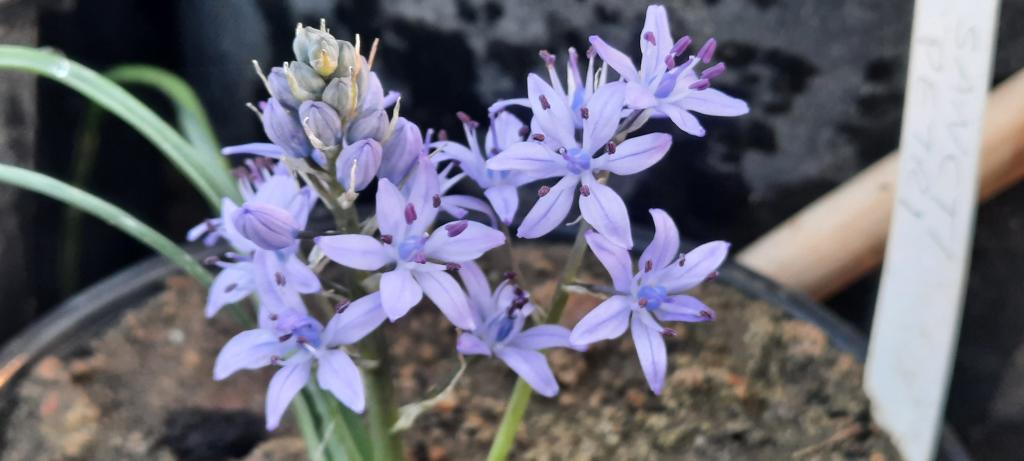
It was first called Scilla ramburei, which is wrong as it honours Rambur, so it should be ramburii.
A second, smaller species has perfumed flowers and was first called Scilla odorata, type locality the Algarve, at Lagos and Cape Sao Vicente, with Narcissus obesus and Hyacinthoides vicentina (mauretanica?), Portugal.
Problems:
The Portuguese botanist Rubim Almeida was the one to write the chapter on Scilla for Flora Iberica, the latest work on the flora of the Iberian peninsula and the Balearic islands.
He identified wrongly a population of Tractema verna as odorata and as he found no difference with true verna (evident) he synonymized odorata with verna (as verna subsp. verna).
In addition to this, he ignored the latest molecular evidence and did not accept Tractema as a distinct genus. This might not have been entirely his fault, as the editors have been consistently on the conservative side since the work was begun in the late eighties.
So well...
Carlos
Today's plant was placed peacefully in Scilla for almost two centuries (from 1800 to 1998).
Rafinesque, for me one of the greatest 'unfairly underrated splitters who were right', disgregated Scilla in many small to rather big genera, often because if presence / absence of bracts and/or bracteoles. He created
Tractema in 1837. It has bracts, but no bracteoles. But the plant remained in Scilla either as a species or lumped in S. verna until Austrian prof. Speta, another underrated visionary, resuscitated Rafinesque's genera in 1998.
Ok, but Tractema verna is an Euro-Siberian plant, and the plant shown here occurs in the Mediterranean climate, from coastal areas on the Atlantic shore on sandy soils, often in Pinus pinea clear forests, with Romulea clusiana and gaditana, etc. to inland oak forests in Cádiz and Málaga provinces at 800 m or more. This plant of mine was accidentally collected in Chiclana, Cádiz, Spain by a friend when looking for Squilla (Urginea/Drimia).
It was first called Scilla ramburei, which is wrong as it honours Rambur, so it should be ramburii.
A second, smaller species has perfumed flowers and was first called Scilla odorata, type locality the Algarve, at Lagos and Cape Sao Vicente, with Narcissus obesus and Hyacinthoides vicentina (mauretanica?), Portugal.
Problems:
The Portuguese botanist Rubim Almeida was the one to write the chapter on Scilla for Flora Iberica, the latest work on the flora of the Iberian peninsula and the Balearic islands.
He identified wrongly a population of Tractema verna as odorata and as he found no difference with true verna (evident) he synonymized odorata with verna (as verna subsp. verna).
In addition to this, he ignored the latest molecular evidence and did not accept Tractema as a distinct genus. This might not have been entirely his fault, as the editors have been consistently on the conservative side since the work was begun in the late eighties.
So well...
Carlos
#35
Current Photographs / Re: March 2024
March 04, 2024, 11:09:51 PM
The 'medium-season' strain of the quite robust, big- flowered, bulbocodium-type Narcissus with narrow and upright to arching leaves, widely distributed in Portugal, and received from Uli, has started blooming (on the right, and at the bottom). It is widely misidentified as obesus, even by Portuguese naturslists, but it is not, and one name given to it seems to be N. bulbocodium subsp. tenuifolius.
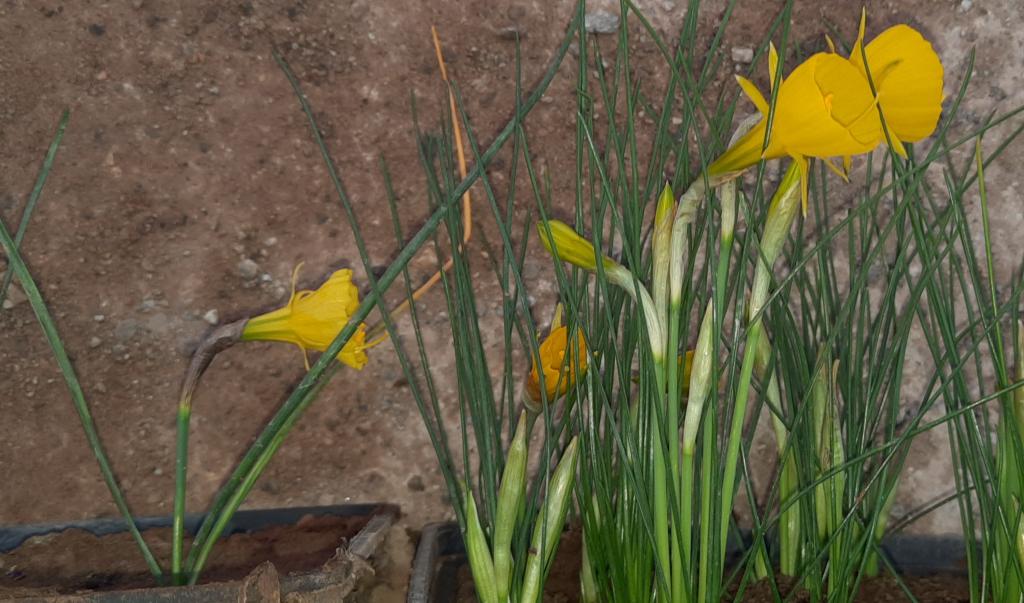
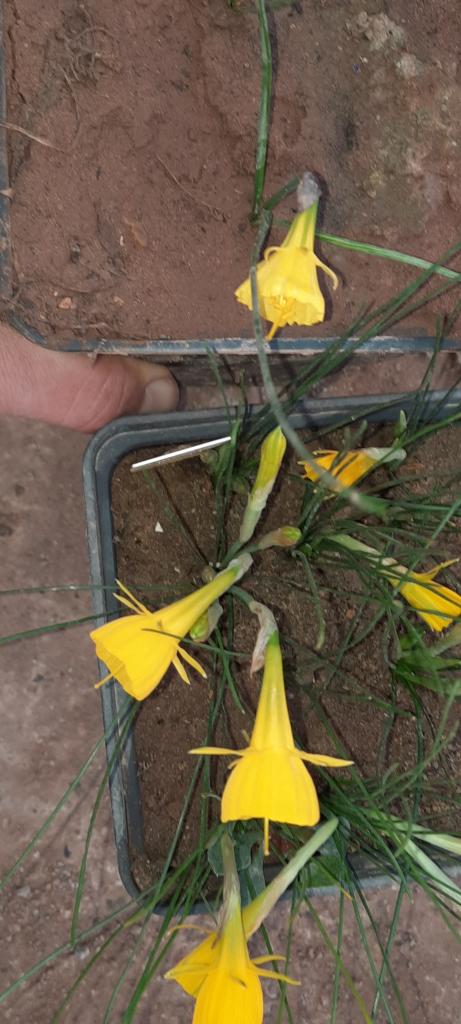
On the left, and at the top in the second photo, another robust bulbocodium from northern central Spain in euro-Siberian climate, growing along streams and in wwet meadows, with much wider and stouter leaves which are not so erect, and flowers more like 'normal bulbocodium'. A name which was undoubtedly published for it is Narcissus bulbocodium subsp. validus, but it lacked a Latin or English diagnose and it is not 'validus' (sorry for the joke). It might be Corbularia conspicua, but when one enters Corbularia territory gets immediately lost in a sea of obscure, short descriptions in Latin from late 17th century or the 18th, with phrases like "it comes from Spain, it comes from the Pyrenees". At least Salisbury included texts in "olde Englifh", which are fun to decipher.
So I still don't know which name is correct, but I will try.
Here the flowers, 'validus/conspicuus" on the right now, tenuifolius on the left.
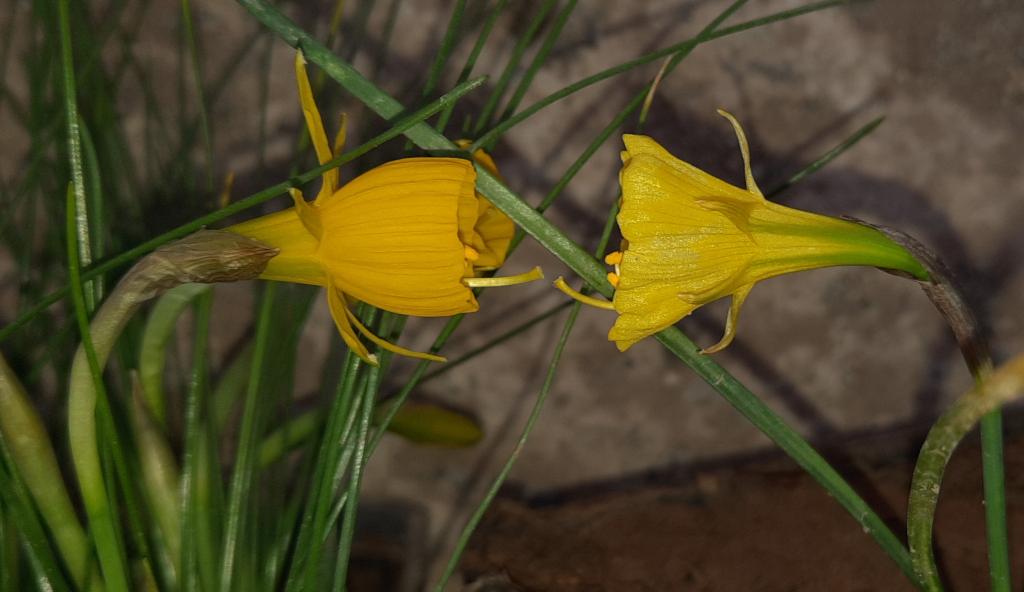
Hoping for some rain...
Carlos
On the left, and at the top in the second photo, another robust bulbocodium from northern central Spain in euro-Siberian climate, growing along streams and in wwet meadows, with much wider and stouter leaves which are not so erect, and flowers more like 'normal bulbocodium'. A name which was undoubtedly published for it is Narcissus bulbocodium subsp. validus, but it lacked a Latin or English diagnose and it is not 'validus' (sorry for the joke). It might be Corbularia conspicua, but when one enters Corbularia territory gets immediately lost in a sea of obscure, short descriptions in Latin from late 17th century or the 18th, with phrases like "it comes from Spain, it comes from the Pyrenees". At least Salisbury included texts in "olde Englifh", which are fun to decipher.
So I still don't know which name is correct, but I will try.
Here the flowers, 'validus/conspicuus" on the right now, tenuifolius on the left.
Hoping for some rain...
Carlos
#36
General Discussion / Re: Private exchanges
February 26, 2024, 10:49:14 PM
Hi, there are fewer of us in the EU, but would it apply as well?
#37
Current Photographs / Re: February 2024
February 24, 2024, 02:39:57 PM
Mine is from him, as well, but he has two clones. First came from Antoine Hoog, he told me himself.
I think we have the same one.
I think we have the same one.
#38
Mystery Bulbs / Re: Hippeastrum warscewiczianum
February 23, 2024, 02:29:11 PM
So after that I was lucky enough to find issue 23 of Allgemeine Gartenzeitung (1855) on the Biodiversity
Heritage Library, without which I would still be just looking after some pots. This is where Dietrich described Hippeastrum warscewiczianum.
Sorry, Uli and Martin, but I was not gladly surprised when I saw a paper in German and Gothic script.
I quickly asked poor Uli and he agreed to translate but had visitors and later I discovered that in a bigger screen I could read it, so I transcribed, google-translated it, and sent it with some adjustments.
Uli said that it had worked and there is still a part pending but I can't wait.
The plant is described as follows (some parts ommitted):
This hippeastrum belongs to the bare-throated division, where there is no paraperigone in the throat, and would differ from the species present in this division by the following characteristics:
Hippeastrum foliis lineari-lanceolatis epruinosis, scapo rorido compresso longioribus; floribus terminalibus geminatis erecto-patentibus; perigonio subregulari campanulato-infundibuliformi usque ad basin sexpartito, laciniis exterioribus latioribus spathulato-lanceolatis carinatis mucronatis, interioribius angustioribus lanceolatis acutis; staminibus stylisque non exertis, lobulis stigmatis minimis subglobosis.
The tepals are dark red above, whitish-green below; the three outer ones are the broader ones, spatulate-lanceolate, one and a half inches wide at the top, with a green stripe on the back which is slightly prominent below [...].The red colour in all of them [the tepals] runs like a stripe down the edge, while the green central stripe merges deeply into the red in the middle. Paraperigone absent.
...Mr. von Warscewicz found this species in Bolivia on the Madeira River in association with several other bulbous plants [e.g. Stenomesson miniatum]. According to its habitat and location, it requires constant warmth, a fairly high level of moisture and a rich soil...
So we have:
1. A 'subregular' perianth. The flowers of mandon⁹ii are strongly zygomorphic, like in other members of the glaucescens complex, and I doubt that anyone would described them as 'subregular'.
2. It lacks a paraperigone. I don't know if mandonii has one...
3. The red-tipped tepals, green below would agree with mandonii, but in mandonii there is no 'green central stripe merging into the red', unless this is a mistake in the translaton (in the original: die rothe Färbung bei allen sich wie ein Streifen am Rande herabziehend, während der grüne Mittelstreifen in der Mitte tief in das Rothe übergeht. Der Kranz an der Basis der Blumentrone fehlt. )
4. A lobed, not trifid stigma. Again I'n sure of how it is in mandonii...
5. The Madeira river begins nowadays (not 100% sur) at the other side of the Bolivian border, already in Brazil, in tbe Amazon basin. One of its tributaries is the Beni river, which comes down from La Paz department, and of which the river Challasuyo, where true mandonii occurs is a tributary. But the climate and flora at 2700 m is totally different.
There could be a mistake in the location of the place, as Stenomesson miniatum occurs at medium elevation (for the Andes).
Dietrich and Lara & al. mention dried specimens, but I still have not located any.
So the mystery goes on, but I am quite convinced that probably warscewiczianum is not the same as mandonii.
What is it? Maybe something similar to this plant:
.
Heritage Library, without which I would still be just looking after some pots. This is where Dietrich described Hippeastrum warscewiczianum.
Sorry, Uli and Martin, but I was not gladly surprised when I saw a paper in German and Gothic script.
I quickly asked poor Uli and he agreed to translate but had visitors and later I discovered that in a bigger screen I could read it, so I transcribed, google-translated it, and sent it with some adjustments.
Uli said that it had worked and there is still a part pending but I can't wait.
The plant is described as follows (some parts ommitted):
This hippeastrum belongs to the bare-throated division, where there is no paraperigone in the throat, and would differ from the species present in this division by the following characteristics:
Hippeastrum foliis lineari-lanceolatis epruinosis, scapo rorido compresso longioribus; floribus terminalibus geminatis erecto-patentibus; perigonio subregulari campanulato-infundibuliformi usque ad basin sexpartito, laciniis exterioribus latioribus spathulato-lanceolatis carinatis mucronatis, interioribius angustioribus lanceolatis acutis; staminibus stylisque non exertis, lobulis stigmatis minimis subglobosis.
The tepals are dark red above, whitish-green below; the three outer ones are the broader ones, spatulate-lanceolate, one and a half inches wide at the top, with a green stripe on the back which is slightly prominent below [...].The red colour in all of them [the tepals] runs like a stripe down the edge, while the green central stripe merges deeply into the red in the middle. Paraperigone absent.
...Mr. von Warscewicz found this species in Bolivia on the Madeira River in association with several other bulbous plants [e.g. Stenomesson miniatum]. According to its habitat and location, it requires constant warmth, a fairly high level of moisture and a rich soil...
So we have:
1. A 'subregular' perianth. The flowers of mandon⁹ii are strongly zygomorphic, like in other members of the glaucescens complex, and I doubt that anyone would described them as 'subregular'.
2. It lacks a paraperigone. I don't know if mandonii has one...
3. The red-tipped tepals, green below would agree with mandonii, but in mandonii there is no 'green central stripe merging into the red', unless this is a mistake in the translaton (in the original: die rothe Färbung bei allen sich wie ein Streifen am Rande herabziehend, während der grüne Mittelstreifen in der Mitte tief in das Rothe übergeht. Der Kranz an der Basis der Blumentrone fehlt. )
4. A lobed, not trifid stigma. Again I'n sure of how it is in mandonii...
5. The Madeira river begins nowadays (not 100% sur) at the other side of the Bolivian border, already in Brazil, in tbe Amazon basin. One of its tributaries is the Beni river, which comes down from La Paz department, and of which the river Challasuyo, where true mandonii occurs is a tributary. But the climate and flora at 2700 m is totally different.
There could be a mistake in the location of the place, as Stenomesson miniatum occurs at medium elevation (for the Andes).
Dietrich and Lara & al. mention dried specimens, but I still have not located any.
So the mystery goes on, but I am quite convinced that probably warscewiczianum is not the same as mandonii.
What is it? Maybe something similar to this plant:
.
#39
Mystery Bulbs / Hippeastrum warscewiczianum
February 23, 2024, 05:08:35 AM
Second research on taxonomy of Hippeastrum, this one was even more fun as it involved transcribing a German text in gothic script into "good" latin alphabet and asking help of another member, Uli, for translation, and another member (or two) for an old paper, Michael Hormick.
In the book Hippeastrum in Bolivia, Lara & al. said (a bit carelessly, for my way of working) that H. warscewiczianum is a synonym of H. mandonii. Then they say that, well, maybe not.
So Carlos thought "there is something going on here" and he went to the original sources.
H. mandonii is easy if you have someone to scan the journal, and I fortunately did. The description is rather lousy but there is an explcit mention to a specimen, which resulted to be several duplicates of a gathering by Mandon near Sorata, in the La Paz department, in the pre-Andes at 2700 m (8800-9000 ft).
Some of the specimens are in a very poor state but some still show the red-tipped petals and the falcate shape of the outer lower tepals. So it was clear, the plant described as H,. mandonii is this:
H. mandonii PBS Wiki
Specimen in Kew Herbarium:
H, mandonii Kew
H. mandonii Paris
I will finish later...
In the book Hippeastrum in Bolivia, Lara & al. said (a bit carelessly, for my way of working) that H. warscewiczianum is a synonym of H. mandonii. Then they say that, well, maybe not.
So Carlos thought "there is something going on here" and he went to the original sources.
H. mandonii is easy if you have someone to scan the journal, and I fortunately did. The description is rather lousy but there is an explcit mention to a specimen, which resulted to be several duplicates of a gathering by Mandon near Sorata, in the La Paz department, in the pre-Andes at 2700 m (8800-9000 ft).
Some of the specimens are in a very poor state but some still show the red-tipped petals and the falcate shape of the outer lower tepals. So it was clear, the plant described as H,. mandonii is this:
H. mandonii PBS Wiki
Specimen in Kew Herbarium:
H, mandonii Kew
H. mandonii Paris
I will finish later...
#40
Current Photographs / Re: February 2024
February 23, 2024, 04:51:47 AM
What the..
I had never heard of that orchid, it is from another world (so many things in Australia are).
Had I known you had A. acaulis, I would have sent some pollen to you. But I was told that it realy is self fertile and it is true. Pedicels coil somewhat like in Cyclamen but not so dramatically, seemingly to get the fruit buried or as close to the ground as possible.
Where is your plant from?
Carlos

I had never heard of that orchid, it is from another world (so many things in Australia are).
Had I known you had A. acaulis, I would have sent some pollen to you. But I was told that it realy is self fertile and it is true. Pedicels coil somewhat like in Cyclamen but not so dramatically, seemingly to get the fruit buried or as close to the ground as possible.
Where is your plant from?
Carlos
#41
Current Photographs / Re: February 2024
February 13, 2024, 11:33:57 PM
Hi, that's Ipheion, probably 'Alberto Castillo'
Carlos
Carlos
#42
Current Photographs / Re: February 2024
February 12, 2024, 11:19:14 PM #44
Mystery Bulbs / Hippeastrum ferreyrae
February 03, 2024, 02:38:29 PM
Hi, I tried to resist but I am finally into Southern Amaryllidaceae, both American and African, for collecting and scientific and conservation purposes.
Taxonomy and nomenclature fall within the scientific part. I started with Hippeastrum.
Thanks to Michael Homick and Paul's efforts I have been able to read many of Traub's descriptions, and hopefully I will have those of Pierfelice (Pedro Félix) Ravenna.
As I soon found out, Traub was a splitter and/or did not read previous papers, and many of his 'species' are useless or synonyms of earlier names (Amaryllis fosteri = stylosum). But I think ferreyrae is good.
Amaryllis ferreyrae was described in Plant Life 6: 62 (1950) from a tiny island in the river Huallaga a couple of loops north of a village known as Yurimaguas, in the Peruvian Amazon basin, as follows (Traub used 'tepalsegs' for the tepals proper:
Bulb with a short neck, 2 cm. long ; leaves 3-4, contemporary with the flowers in September (Peru), to 55 cm long, 3 cm at the middle, lorate-lanceolate-acute above, narrowed to 6 mm at the base ; peduncle 15-19 cm tall, about 1.5 cm in diameter at the base, 4 5 mm at the apex; umbel 2-flowered; spathe 2-valved, valves free to the base, lanceolate, 6 cm long; pedicels 8-9.5 cm. long; ovary 10 mm long, 6 mm wide; perigone wide open, red; tepaltube slender, 2.5 cm long; paraperigone absent; the perigone-limb of 6 tepalsegs 9 cm. long, tepalsegs
3-4 cm wide at the middle, pointed at the apex; the 6 stamens of 4 sets of lengths, attached at the mouth of the tepaltube, 6.5 cm long, slightly shorter than the style which is shorter than the tepalsegs ; stamens and style declinate-ascending; anthers 7 mm long; stigma flat, triangular on top. Type specimen Ferreyra 4997, accession in Traub Herbarium nos. 111-112. Collected by Dr. Ramon Ferreyra on the Isla Santa Maria, near Yurimaguas, Huallaga Valley, Dept. Loreto, Peru, alt. 150 200 m.
in the forest, Sept. 16, 1948.
Notes. This fine species belongs in the Subgenus Aschamia. It differs from Amaryllis Leopoldii in color pattern of the flower, and in having less regular tepalsegs, and shorter stamens and style, and from Amaryllis Reginae in having leaves fully developed with the flowers, spathe-valves shorter than the pedicels, a longer tepaltube, and a style shorter than the tepalsegs. Amaryllis Ferreyrae will represent a fine addition to the germplasm collection of the Amaryllis breeder. It is named in honor of Dr. Ramon Ferreyra.
So, we have a synanthous plant, with red flowers and no paraperigone, related to H reginae and H. leopoldii.
My point is: the photos in the PBS Wiki don't seem to me to fit this description, it seems a hybrid or a variation of H. puniceum. Puniceum has a fimbriated paraperigone.
https://www.pacificbulbsociety.org/pbswiki/index.php/HippeastrumSpeciesOne#
https://www.pacificbulbsociety.org/pbswiki/index.php/HippeastrumSpeciesOne#
Images of what some observers consider H. ferreyrae:
https://www.inaturalist.org/observations/69428136
https://www.inaturalist.org/observations/193090067
Puniceum in the Peruvian Amazon:
https://www.inaturalist.org/observations/190503647
https://www.inaturalist.org/observations/181612055
https://www.inaturalist.org/observations/67999248
Some seem to have the line on tepals 3 and 5.
I'll be back with more.
Carlos
Taxonomy and nomenclature fall within the scientific part. I started with Hippeastrum.
Thanks to Michael Homick and Paul's efforts I have been able to read many of Traub's descriptions, and hopefully I will have those of Pierfelice (Pedro Félix) Ravenna.
As I soon found out, Traub was a splitter and/or did not read previous papers, and many of his 'species' are useless or synonyms of earlier names (Amaryllis fosteri = stylosum). But I think ferreyrae is good.
Amaryllis ferreyrae was described in Plant Life 6: 62 (1950) from a tiny island in the river Huallaga a couple of loops north of a village known as Yurimaguas, in the Peruvian Amazon basin, as follows (Traub used 'tepalsegs' for the tepals proper:
Bulb with a short neck, 2 cm. long ; leaves 3-4, contemporary with the flowers in September (Peru), to 55 cm long, 3 cm at the middle, lorate-lanceolate-acute above, narrowed to 6 mm at the base ; peduncle 15-19 cm tall, about 1.5 cm in diameter at the base, 4 5 mm at the apex; umbel 2-flowered; spathe 2-valved, valves free to the base, lanceolate, 6 cm long; pedicels 8-9.5 cm. long; ovary 10 mm long, 6 mm wide; perigone wide open, red; tepaltube slender, 2.5 cm long; paraperigone absent; the perigone-limb of 6 tepalsegs 9 cm. long, tepalsegs
3-4 cm wide at the middle, pointed at the apex; the 6 stamens of 4 sets of lengths, attached at the mouth of the tepaltube, 6.5 cm long, slightly shorter than the style which is shorter than the tepalsegs ; stamens and style declinate-ascending; anthers 7 mm long; stigma flat, triangular on top. Type specimen Ferreyra 4997, accession in Traub Herbarium nos. 111-112. Collected by Dr. Ramon Ferreyra on the Isla Santa Maria, near Yurimaguas, Huallaga Valley, Dept. Loreto, Peru, alt. 150 200 m.
in the forest, Sept. 16, 1948.
Notes. This fine species belongs in the Subgenus Aschamia. It differs from Amaryllis Leopoldii in color pattern of the flower, and in having less regular tepalsegs, and shorter stamens and style, and from Amaryllis Reginae in having leaves fully developed with the flowers, spathe-valves shorter than the pedicels, a longer tepaltube, and a style shorter than the tepalsegs. Amaryllis Ferreyrae will represent a fine addition to the germplasm collection of the Amaryllis breeder. It is named in honor of Dr. Ramon Ferreyra.
So, we have a synanthous plant, with red flowers and no paraperigone, related to H reginae and H. leopoldii.
My point is: the photos in the PBS Wiki don't seem to me to fit this description, it seems a hybrid or a variation of H. puniceum. Puniceum has a fimbriated paraperigone.
https://www.pacificbulbsociety.org/pbswiki/index.php/HippeastrumSpeciesOne#
https://www.pacificbulbsociety.org/pbswiki/index.php/HippeastrumSpeciesOne#
Images of what some observers consider H. ferreyrae:
https://www.inaturalist.org/observations/69428136
https://www.inaturalist.org/observations/193090067
Puniceum in the Peruvian Amazon:
https://www.inaturalist.org/observations/190503647
https://www.inaturalist.org/observations/181612055
https://www.inaturalist.org/observations/67999248
Some seem to have the line on tepals 3 and 5.
I'll be back with more.
Carlos
#45
Current Photographs / February 2024
February 03, 2024, 01:05:02 PM
A bit late due to unusually (getting to be usual) hot weather in autumn and early winter.
Narcissus × bastitanus (blancoi × cantabricus). Two individuals.
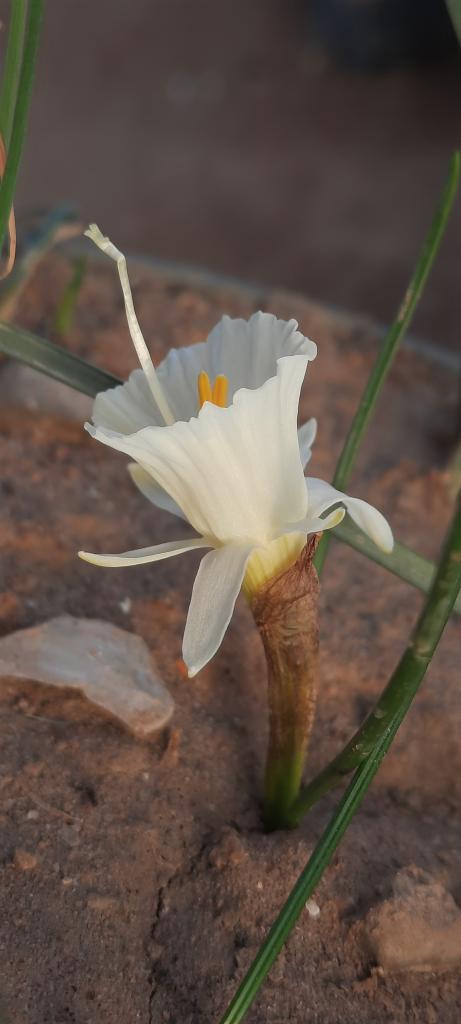
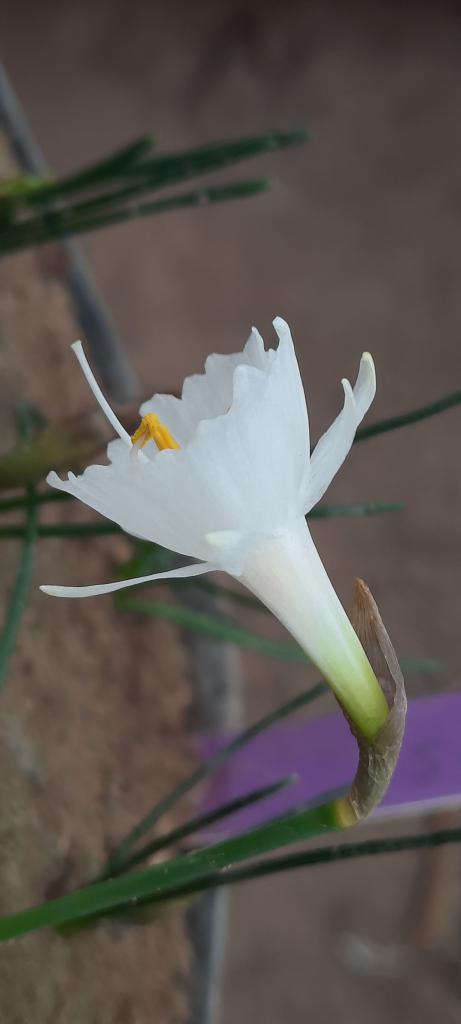
And Uli's early strain of bulbocodium, which is not just bulbocodium, but I still don't know how to name (NOT obesus).
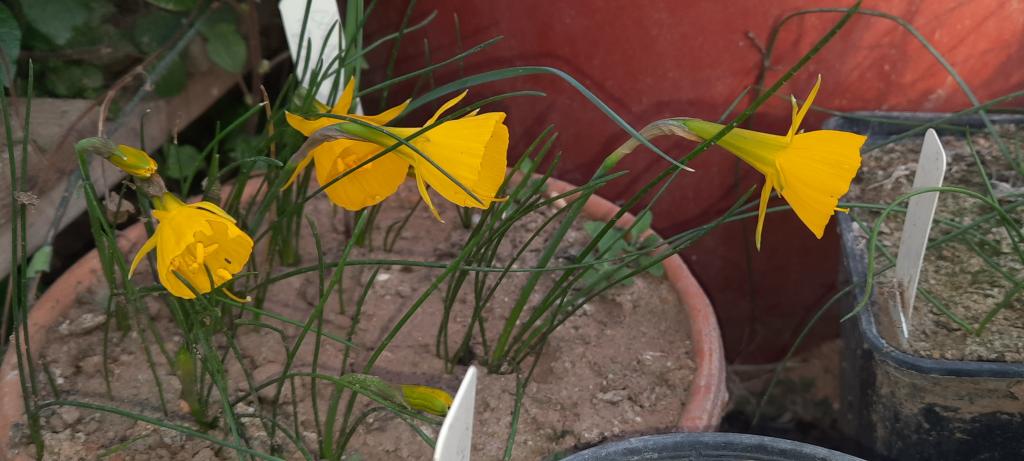
Carlos
Narcissus × bastitanus (blancoi × cantabricus). Two individuals.
And Uli's early strain of bulbocodium, which is not just bulbocodium, but I still don't know how to name (NOT obesus).
Carlos
